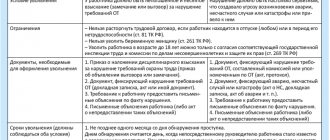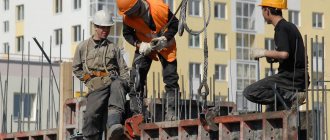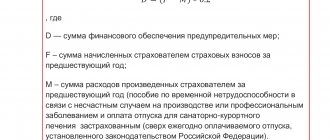What are occupational safety briefings?
Occupational safety briefing is a mandatory element of the industrial safety system.
The legislator obliges every company whose employees work in the real sector of the economy to organize such briefings (Articles 212, 225 of the Labor Code of the Russian Federation). IMPORTANT! Occupational safety training is not voluntary for company employees. They must attend such classes without fail, otherwise they will not receive the right to begin fulfilling their production task (Articles 212, 214 of the Labor Code of the Russian Federation).
In order to correctly organize training, the company should be guided by the resolution of the Ministry of Labor of the Russian Federation, the Ministry of Education of the Russian Federation “On the Procedure for Training in Labor Safety” dated January 13, 2003 No. 1/29 (hereinafter referred to as Procedure No. 1/29), as well as the provisions of GOST 12.0.230-2007, approved by order of Rostechregulirovanie dated July 10, 2007 No. 169-st.
There is a possibility that from March 1, 2022, Order No. 1/29 will be canceled. This follows from the provisions of the draft order of the Russian Ministry of Labor, published in September 2022.
At the same time, at the regulatory level, legislation in the field of labor protection will in any case undergo large-scale changes from March 1, 2022. For details, see the special material prepared by ConsultantPlus experts. Get free access to the system.
The legislator identifies the following types of labor safety briefings (clause 2.1 of Procedure No. 1/29):
- introductory;
- primary;
- repeated;
- unscheduled;
- target.
Each briefing should be organized at work upon the occurrence of events specified by the legislator. However, despite the variety of types of instruction, they all boil down to the following: the instructor (enterprise representative) explains to the employee what dangerous factors he may encounter and how the employee can work safely for himself and others. In addition, during the briefing, the employee should gain an understanding of which regulations and internal documents of the company stipulate labor safety requirements.
Induction training
So, immediately after a specialist starts working at an enterprise, the employer is obliged to provide him with induction training. In addition, induction training should be carried out not only with our own, but also with specialists sent from other organizations, employees of other companies, workers at the production site assigned to the company, students undergoing practical training (clause 2.1.2 of Procedure No. 1/29 ).
The director is the only participant and employee of the LLC and conducts his own introductory briefing on labor protection. Read more here.
IMPORTANT! Induction training is an event that the employer can organize not at the employee’s workplace, but in various territories and facilities controlled by the employer (clause 8.6 of GOST 12.0.004-2015).
During such instruction, as a rule, new employees are introduced to the company as a whole, the structure of the enterprise, features of production, etc. are explained to them. Next, the instructor must explain to the specialists the norms of the current legislation on labor protection, and also inform them what internal documents (instructions, rules, etc.) in this regard are in force in the company.
You can get acquainted with the specifics of using standard instructions on labor protection by profession here.
An important place is occupied by a description in the introductory briefing of the possible negative impact of hazardous factors, in connection with which the instructor should necessarily cover fire safety issues, methods of providing first aid in case of an accident, etc. A detailed list of questions to which the employee must receive answers in during the introductory briefing, enshrined in Appendix 3 to Order No. 1/29.
NOTE! In addition to labor safety induction training, in accordance with subpara. “g” clause 3 of the Regulations approved by Decree of the Government of Russia dated November 2, 2000 No. 841, all newly hired employees should be given introductory training in civil defense.
Targeted briefing
Targeted instruction is carried out when performing one-time work not related to direct responsibilities in the specialty (loading, unloading, cleaning the territory, one-time work outside the enterprise, workshop, etc.); liquidation of consequences of accidents, natural disasters and catastrophes; production of work for which a permit, permit and other documents are issued; conducting excursions at the enterprise, organizing public events (excursions, hikes, sports competitions, etc.).
Targeted briefing with employees carrying out work according to work permit, order, etc. recorded in the work permit or other documentation authorizing the execution of work.
How to make occupational safety instructions
The procedure for developing, approving, revising and taking into account labor protection instructions for employees is described in the Methodological Recommendations for the development of state regulatory requirements for labor protection (approved by Resolution of the Ministry of Labor of Russia dated December 17, 2002 No. 80).
Instructions for workers by profession and for certain types of work are developed in accordance with the list compiled by the head of the labor protection service.
Initial briefing on labor protection
After the introductory briefing, in order to be allowed to perform a task in production, the employee must receive the necessary instructions within the framework of his workplace, i.e., undergo initial briefing.
NOTE! In this case, such instruction must be carried out personally by the supervisor of the employee being instructed (for example, a foreman, foreman, etc.).
As for the composition of persons required to undergo initial briefing, there are no changes compared to the introductory briefing: everyone who in one way or another participates in production activities must be instructed on the spot (clause 2.1.4 of Procedure No. 1/29.)
IMPORTANT! If the employee’s activities do not involve the direct use of production equipment, as well as raw materials, he may be exempt from undergoing initial training. But only if this fact is normatively approved by the employer.
Initial instruction, as already mentioned, is carried out directly at the place where the employee will subsequently work. However, an exception is possible: if there are positions/workplaces similar in their functionality, the instructor has the right to conduct general instruction for such employees within the general workplace.
The range of issues that should be covered during the initial briefing slightly overlaps with the introductory briefing program, with the difference that now the instructor shows the employee in practice the techniques and methods of ensuring safety during work within a specific workplace.
During this briefing, the employee receives information not about abstract production chains at the enterprise, but about the specific production line in which he will be involved:
- about dangerous factors on such a line;
- how to prepare your place for work and subsequently keep it safe;
- safety rules when moving around the territory of the plant/workshop where he will work;
- the possible occurrence of emergency situations and how to avoid them, etc.
A more complete list of questions for initial briefing is established in Sample Program B.2, given in Appendix B to GOST 12.0.004-2015
NOTE! If an employee has not learned the information during the initial training, he will not be allowed to work independently. Such a specialist must undergo re-instruction and a second test, which is scheduled no later than a month after the previous one, which showed an unsatisfactory assessment of knowledge (clause 6.12 of GOST 12.0.004-2015).
Frequency of labor safety briefings (repeated briefings)
As follows from the above, at any manufacturing enterprise, all employees directly involved in production have successfully completed initial training. However, over time, an employee’s knowledge of the basics and principles of safe work at his or her workplace may deteriorate.
To prevent this from happening, the legislator obliges the enterprise to organize repeated training on labor protection every six months (clause 2.1.5 of order No. 1/29). Such instruction is similar to the initial one: it is carried out with the same persons, individually with each or a group of employees performing similar functions. As a result, the list of questions that the instructor must cover during the repeated briefing exactly repeats the list for the initial one (clause 8.8. GOST 12.0.004-2015).
With regard to repeated instruction, the general rule applies: if an employee shows unsatisfactory results during testing of acquired knowledge, he is removed from work and must undergo instruction again at a later date.
For more information about re-instruction, see the article “When re-instruction is carried out (nuances)” .
How is the procedure performed?
As a rule, for different types of labor safety briefings, the procedure will be the same:
- Employees are told about hazardous production factors, familiarize them with safety instructions and other documentation.
- Responsible specialists who conducted the relevant types of occupational safety training at the enterprise check how employees have mastered the acquired knowledge. Most often, verification is carried out orally.
- The fact of each of the 5 types of labor safety briefings is recorded in special separate journals.
Employees who have not passed the test do not have the right to begin performing work functions. They will have to undergo training again. The procedure is carried out with a group of employees or individually with each employee.
Conducting unscheduled and targeted briefings on labor protection
In addition to scheduled briefings (repeated), conducted by the company periodically as usual, there are briefings that must be carried out in the event of certain emergency circumstances. Such briefings are called unscheduled. The company must conduct them in the following cases (clause 2.1.6 of Procedure No. 1/29):
- if any new regulatory documents (both federal and local) regulating labor protection procedures come into force;
- changes occur in the production line (for example, modernization of equipment), as a result of which significant labor safety conditions in such production change;
- an emergency situation occurred at the enterprise (equipment breakdown, industrial accident);
- there are long interruptions in production;
- The organization of such instruction is required by the regulatory federal body or the management of the enterprise.
For more information on conducting such a briefing, see the article “How to conduct an unscheduled briefing (nuances)” .
In addition, the legislator obliges the company to organize targeted training (clause 2.1.7 of Procedure No. 1/29) and in some other circumstances. These include:
- assigning an employee work of a one-time nature;
- liquidation of consequences of various natural disasters;
- admission of a specialist to work that requires some kind of permit (for example, a work permit);
- a mass event planned at the enterprise.
Both unscheduled and targeted training should be carried out at the workplace. It is allowed to instruct workers not only individually, but also to conduct collective instruction for specialists performing functions similar in content (within a common workplace).
The specific content of the briefing (the list of issues that require coverage) is determined in each case separately. For example, when eliminating the consequences of natural disasters, it is necessary to familiarize the employee with different methods of ensuring occupational safety than when modernizing the equipment on which he works.
How to conduct occupational safety training for managers and specialists is described in ConsultantPlus. Sign up for a free trial and read the material.
Types of occupational safety briefings
In accordance with Art. 225 of the Labor Code of the Russian Federation, all employees (including heads of organizations and individual entrepreneurs) are required to undergo occupational safety training and knowledge testing. Training for ordinary employees is carried out in the form of briefings.
Briefing is a training procedure that addresses safety issues in the organization, as well as at each workplace. Completing it will allow the employee to remember the dangers that he may encounter during work and their consequences. A knowledge test at the end of training reinforces the material covered. Ideally, a trained worker should use the equipment correctly, not violate labor safety requirements, and follow the rules of technical safety regulations.
The conditions for conducting, the list of existing occupational safety briefings and their contents are listed in the “Procedure for OSH training...”, approved. joint Resolution of the Ministry of Labor and the Ministry of Education of the Russian Federation dated January 13, 2003 No. 1/29, as well as GOST 12.0.004-90 SSBT. As stated in Art. 212, persons who have not completed training, internship (from 2 to 14 shifts) and knowledge testing are not allowed to work.
Therefore, we will consider in more detail what types of occupational safety briefings there are and in what cases they are carried out.
Introductory
Introductory training on occupational safety is carried out on the first day of work:
- with all persons hired;
- with employees seconded to the organization;
- with workers of third-party organizations performing work on the territory of the enterprise;
- with trainees, etc.
Conducting introductory briefings on occupational safety is the responsibility of an occupational safety specialist or an employee appointed by decree of the manager.
During it, workers study:
- main provisions of legislation relating to occupational safety;
- rules of conduct at work;
- PPE;
- information about emergency situations in the company or similar enterprises;
- procedure for admission to independent work, etc.
What types of occupational safety training are carried out besides those we discussed above? These are primary workplace, repeated, unscheduled and targeted briefings. These types of safety and labor protection briefings are carried out by the worker’s immediate supervisor, who has undergone occupational safety training and knowledge testing.
Primary
Initial instruction on occupational safety in the workplace is carried out by the head of the unit or, on his instructions, by the foreman.
It is carried out before independent work:
- with all the newcomers;
- seasonal workers;
- with employees with whom a fixed-term contract has been concluded for a period of up to 2 months;
- with displaced or transferred employees;
- with posted workers;
- with interns;
- with persons who are entrusted with performing work that is new to them, etc.
Persons whose work is not associated with danger may be exempt from this type of instruction.
The training program includes:
- general familiarization with the technological process at the work site;
- familiarization with the equipment;
- procedure for preparing for work;
- PPE requirements;
- cases of industrial injuries and their causes;
- safety requirements when working with electrical equipment and lighting devices;
- first aid measures;
- liability for violation of OT rules.
Induction and initial training at the workplace are carried out according to specially developed and approved programs by the employer.
Repeated
The goal is to consolidate previously acquired knowledge. Conducted according to initial training programs at the workplace.
All employees specified in the previous paragraph undergo repeated training on occupational safety. It is carried out at least once every 6 months. For workers servicing high-risk equipment, it is carried out at least once every 3 months. Workers whose activities do not involve danger may be exempt from this activity. But in order to document this, the boss is obliged to issue a corresponding order.
Unscheduled
Unscheduled safety training is required:
- upon the introduction of new or amended standards containing occupational safety requirements, as well as instructions on occupational safety;
- when changing technological processes, replacing or upgrading equipment and other factors affecting labor safety;
- in case of violation of labor safety requirements by workers, if this caused an accident or accident;
- at the request of regulatory authorities;
- during breaks in work. For work with harmful and (or) dangerous conditions - more than 30 calendar days, and for others - more than 2 months;
- at the discretion of the employer.
Target
It is carried out for certain tasks:
- when performing one-time work;
- when eliminating the consequences of accidents, emergencies;
- when performing work for which a permit or permit is issued;
- when holding mass events at the enterprise.
So, we have reviewed the list of existing occupational safety instructions. The fact that an employee has undergone one or another instruction is recorded in special journals and confirmed by the signatures of the instructor and the person being instructed.
Each type of training ends with testing the employee’s knowledge and skills in safe working methods. The instructor checks your knowledge. Persons who show unsatisfactory test results are not allowed to work independently and are required to undergo training again.
The procedure for conducting labor safety briefings
All types of labor safety briefings at the enterprise must be carried out according to a specially approved program, which lists the main issues that require coverage within each type. For unscheduled or targeted briefings, the employer must provide different questions depending on the occurrence of a specific circumstance that requires the briefing.
During any training other than introductory training, the instructor should not only explain some theoretical principles to the specialists, but also illustrate in practice a set of basic methods and techniques that allow them to make their work as safe as possible.
At the end of the briefing, the employee must verbally report that he has mastered the material, and the company representative, accordingly, must check the knowledge acquired by the employee (clause 2.1.3 of order No. 1/29). And if the employee shows unsatisfactory results, he will not be allowed to continue working in production, but will be sent for repeated training.
As for documenting the conduct of briefings, one should not forget to register them in the appropriate journals.
NOTE! To register briefings conducted at the workplace, one journal is provided (Form A.5 in Appendix A to GOST 12.0.004-2015), and the conduct of induction training is recorded in another (Form A.4 in Appendix A to GOST 12.0.004-2015). 2015).
Find out more about these magazines from the articles:
- “Journal of introductory training on labor protection - sample”;
- “Sample logbook for workplace training.”
In addition, it is advisable to make a note about the conduct of one or another briefing with the employee in the personal training card (in the form recommended in Form A.2 in Appendix A to GOST 12.0.004-2015).
You can find out more about the specifics of each type of labor safety briefing in a special material published in the ConsultantPlus system. Free trial access is available for you.
Initial training at the workplace
It is carried out with everyone before starting independent work. Conducting labor safety briefings includes familiarizing workers with existing hazardous or harmful production factors, studying labor safety requirements contained in the organization’s local regulations, labor safety instructions, technical and operational documentation, as well as the use of safe methods and techniques for performing work.
Initial instruction on labor protection sampleAttention! Important note! Initial instruction is provided by profession and type of work. We bring to your attention general instructions for all employees. Despite its versatility, it cannot always replace the others. |
The labor safety briefing ends with an oral assessment of the employee’s acquired knowledge and skills in safe work practices by the person conducting the briefing.
All types of briefings are recorded in the briefing log.
Download the workplace briefing log form |
Not all employees are required to undergo on-the-job training. If the responsibility to instruct lies with the boss, then who will instruct the director? Or why instruct people who themselves have the right to instruct employees?
Employees may be exempt from undergoing initial training at the workplace. The list of professions and positions of employees exempt from undergoing initial training at the workplace is approved by the employer.
list of those exempt from workplace training |
Results
Conducting occupational safety training is an important component of ensuring industrial safety, which is mandatory for companies by law.
Thus, for all new specialists, the company must organize introductory training, upon successful completion of which workers will receive the necessary instructions directly at the workplace. If, during the test, employees show that they have mastered the material received during the instruction, they may be allowed to work independently.
In addition, every six months it is necessary to refresh the knowledge of employees in the field of labor protection and, for this purpose, conduct repeated briefings.
At the same time, it is possible that emergency circumstances may arise that may require the company to conduct unscheduled or targeted training. It is important for the company to monitor the relevance of its programs for each type of instruction, and, if necessary, make additions and clarify the issues covered.
Conducting training for employees is not the only responsibility of employers in the field of labor protection.
You can get acquainted with other key ones in a special material. You can find more complete information on the topic in ConsultantPlus. Free trial access to the system for 2 days.
Testing knowledge on OT
The main and main criterion for the mastery of labor protection requirements by those who have undergone instruction is the successful testing of their knowledge of labor protection requirements. Each briefing is considered successfully completed if the employee has proven that he has mastered the information received. Usually this is done through an oral examination. Only after this the employee can begin to perform work duties.
The fact of carrying out occupational safety training is recorded in a special journal indicating the date. The instructor and employee must sign.
All data related to the briefings and testing of occupational safety knowledge must be taken into account during the external audit of occupational safety and health.
If, when checking the State Labor Inspectorate, it is discovered that there are no documents confirming that briefings and inspections were actually carried out, the employer, on the basis of Art. 5.27.1. The Code of Administrative Offenses of the Russian Federation faces a fine of 15 to 130 thousand rubles.







